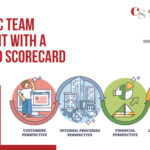8 Tips For Aligning Organizational and Departmental Goals For Maximum Impact
Organizational success is achieved when every department operates like a well-tuned cog in a larger machine, working collaboratively toward a shared purpose. However, this level of alignment is easier said than done — miscommunication, siloed functions, and unclear priorities often hinder progress. Aligning organizational and departmental goals requires a strategic approach to ensure all teams are pulling in the same direction. This alignment not only optimizes resources but also enhances overall efficiency and morale.
At CerveauSys Strategic, the Best HR OD Consulting Firm in Pune, we firmly believe that fostering a culture of clarity, collaboration, and accountability, businesses can create a unified workforce that consistently delivers high-impact results. Here are 8 actionable tips to help organizations achieve this level of synergy.
8 Tips to Align Organizational and Departmental Goals
1. Develop a Clear Vision and Mission
A well-defined and shared vision acts as the foundation for organizational goal-setting. It provides all departments with a sense of direction and a unified purpose. When employees across levels understand the organization’s ultimate vision and mission, they can identify how their tasks contribute to long-term success. Leaders should regularly communicate this vision through open forums, leadership town halls, and strategy workshops. Clarifying how departmental objectives feed into the larger purpose ensures that no one operates in isolation.
Moreover, this shared vision prioritizes efforts and fosters collaboration rather than competition among departments. For instance, a supply chain department striving for cost efficiency will work better with sales teams focused on elevating customer satisfaction when both groups understand how individual contributions ladder up to the organization’s mission.
2. Set SMART Goals
SMART (Specific, Measurable, Achievable, Relevant, and Time-bound) goals are crucial to bridge the gap between organizational strategy and departmental execution. SMART goals provide clarity and act as a roadmap, ensuring measurable outcomes across all verticals. Particularly for departments, creating specific goals effectively translates high-level aspirations into actionable tasks.
For example, if the organization’s objective is to improve its market share by 20%, all relevant departments should create SMART goals aligned with this strategy. The marketing department can focus on increasing digital outreach by 50%, while the sales team might aim at closing a minimum of 15% more leads within a quarter. Each team’s progress feeds directly into the broader business objectives. Additionally, SMART goals eliminate ambiguity, empowering managers to allocate resources efficiently without overlapping priorities.
3. Foster Interdepartmental Collaboration
Siloed departments can derail the alignment between organizational and departmental goals. One of the most effective ways to combat this is fostering collaboration across teams. When departments coordinate, they can cross-leverage their strengths and prevent redundancies in effort and resources.
To encourage such collaboration, organizations should promote transparency by creating cross-functional project teams, implementing shared technology platforms, and conducting regular interdepartmental meetings. For instance, bringing the marketing and product development teams together to work on customer-centric goals ensures smooth transitions from ideation to execution. Tools like shared dashboards and project management systems improve visibility across teams, streamlining workflows.
4. Deploy Clear Communication Channels
Effective communication is the backbone of aligning goals at every level. Without clear channels, misunderstandings can lead to misaligned departmental priorities. Organizations must focus on creating seamless upward, downward, and lateral communication pathways for goal alignment.
Leaders should initiate this by clearly articulating organizational objectives and cascading them to departmental heads, who translate them into individual team goals. Tools like internal newsletters, strategy presentations, and intranet updates can ensure alignment across departments.
Regular progress meetings and transparent discussions around changes in direction also reinforce alignment. For instance, department heads should periodically update their teams about how their progress impacts organizational objectives. Moreover, encouraging real-time feedback allows employees to voice concerns, making it easier to adjust strategies.
5. Use Key Performance Indicators (KPIs) to Measure Progress
Tracking performance is essential to ensure departmental and organizational goal alignment. Establishing clear and relevant KPIs provides insights into where departments stand concerning their objectives and how they contribute to broader organizational goals. Well-designed KPIs take into account the specific role of each department and their interlinkages with high-level goals.
For instance, an HR department focusing on employee retention can measure success through metrics like turnover rates and employee engagement scores. Meanwhile, a sales department can track revenue growth, conversion rates, or customer satisfaction. Aligning these KPIs to the organization’s overarching goals ensures that all departments are working toward the same milestones, albeit through tailored efforts. Visualizing KPIs through analytics dashboards or balanced scorecards provides leaders with ongoing insights into performance gaps, allowing early course correction.
6. Foster a Culture of Accountability and Recognition
Alignment thrives in a culture of accountability where employees take responsibility for their contributions to both departmental and organizational goals. Building such a culture starts with clarity. Leaders should set transparent ownership for tasks and outcomes, ensuring every team member understands their responsibilities.
Additionally, organizations should encourage frequent reviews and feedback sessions to assess progress toward set goals. These check-ins don’t just promote accountability but also offer opportunities to address challenges and adjust priorities. Recognizing achievements is equally important. Celebrating department-level successes linked to organizational goals fosters morale and reinforces alignment. Recognition programs, whether through incentives or public acknowledgments, can motivate teams to remain committed to high-impact results.
7. Rely on Technology and Data Analytics
In today’s fast-paced business environment, digital tools and data can be game-changers for goal alignment. Technology platforms like ERP systems and performance management software bring real-time visibility into progress across departments, enabling informed decision-making.
For example, organizations can use advanced analytics tools to evaluate how departmental tasks influence enterprise-level outcomes. Predictive insights from data can also guide future goal-setting. Project management tools ensure seamless coordination across teams, preventing misaligned priorities. By embedding technology into operations, organizations can better align individual and team efforts with their overarching mission, ensuring optimal impact.
8. Continuously Monitor and Adapt Goals
The business landscape is dynamic, and goals need consistent evaluation to stay relevant. Organizations should establish frameworks for periodic reviews and goal pivots based on external changes such as economic shifts, market trends, or evolving customer demands.
Leaders must encourage teams to embrace a growth mindset, treating goal refinement as an ongoing process rather than a one-time effort. For instance, following a sudden dip in market share, a customer service department may revise its KPIs to focus more on response times or satisfaction ratings. This agility ensures that departmental activities continuously feed into broader strategic goals despite external challenges.
The Bottom Line
Aligning organizational and departmental goals is not just about strategy—it’s about creating a culture of collective ownership, accountability, and collaboration. By adopting these 8 tips, organizations can achieve optimal synergy between every department and strengthen their foundation for long-term success.
For businesses seeking expert guidance in organizational alignment, CerveauSys Strategic is your trusted partner. As the Best HR and OD Consulting Firm in Pune, we specialize in aligning people’s performance, organizational strategies, and processes to ensure maximum impact. Whether you’re looking for organizational diagnosis, strategy formulation, or leadership development, CerveauSys Strategic offers tailored solutions to bring clarity and efficiency to your business growth efforts. Partner with us to transform your challenges into opportunities and achieve unparalleled success.



